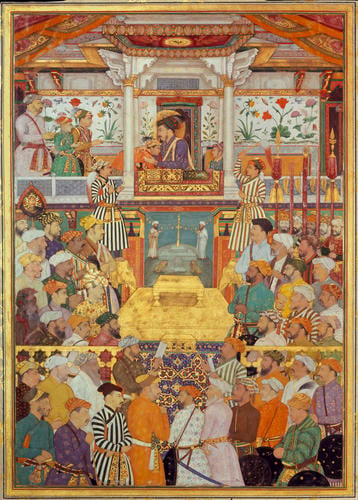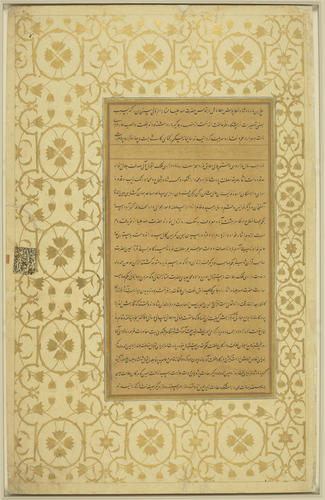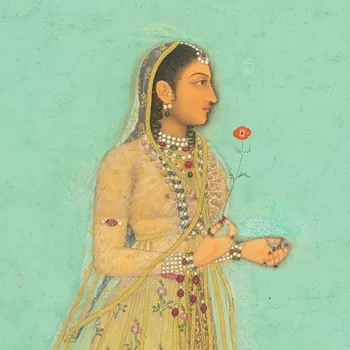Shah-Jahan receives his three eldest sons and Asaf Khan during his accession ceremonies (8 March 1628) c. 1630 - 1650
Painting in opaque watercolour including metallic paints. | 30.6 x 21.3 cm (image) | RCIN 1005025.k

Bichitr
Master: Padshahnamah ?????????? (The Book of Emperors) ?? Item: Shah-Jahan receives his three eldest sons and Asaf Khan during his accession ceremonies (8 March 1628) c. 1630 - 1650

Bichitr
Master: Padshahnamah پادشاهنامه (The Book of Emperors) Item: Shah-Jahan receives his three eldest sons and Asaf Khan during his accession ceremonies (8 March 1628) c. 1630 - 1650



-
Padshahnamah fol. 50v (plate 10)
The sons of Shah-Jahan pay him homage during his accession ceremony at the Agra Fort in March 1628.
Shah-Jahan ascended the Mughal throne age 36 after the death of Jahangir on 8 November 1627. This painting depicts a durbar held as part of his formal accession ceremonies staged at the Agra Fort the following spring. The text describes how the new Emperor’s three eldest sons, Dara-Shukoh, Shah-Shuja and Awrangzeb each in turn kissed the ground and presented their father with a nazr (gift) of gold coins. The painter Bichitr depicts Shah-Jahan kissing his eldest son Dara-Shukoh on the forehead while the others look on. Shah Jahan’s father, Jahangir, had kept his grandsons as hostages in Lahore while their father was in exile following his rebellion in 1622. Asaf Khan, Shah-Jahan’s father-in-law, seen on the far left of the balcony, played a central role in Shah-Jahan’s coming to power after Jahangir’s death and escorted the Princes from Lahore to Agra for the accession events. This painting therefore commemorates an important reunion after almost six years of separation. The Padshahnamah text describes the delight of Shah-Jahan and his wife Mumtaz-Mahal seeing their sons for the first time the day before this ceremony took place: ‘The parents’ joy after such a long time was indescribable inasmuch as in the workshop of rhetoric there is no expression that can convey such joy. The entire day was spent by the parents admiring the beauty of their grand sons. The next day...all the nobles and grandees went out by royal command to greet the princes and escort them and Asaf Khan to court. When the jharoka...was illuminated by the rays of the Emperor's enthronement, the princes and Asaf Khan were allowed to pay homage.' On the right of the Emperor is Prince Murad Bakhsh, then only three years old, meeting his brothers for the first time.
Below the Emperor to the left and right, attendants hold imperial insignia including the sunshade (aftab-gir) and standards (alam) wrapped in scarlet cloth. Other servants, seen here standing on two gold elephants, fanned the Emperor as he sat. A strict hierarchy governed who stood where and in what proximity to the Emperor during the ceremony, with nobles of highest rank positioned nearest. In this painting many of the figures are named in tiny inscriptions, allowing us to identify two Rajput rajahs closest to the Emperor on the left: Gaj Singh of Jodhpur, cousin of the Emperor, and Ratan Singh of Bundi, who travelled from his homeland to Agra to pay homage to the Emperor on his accession. First on the right is the Iranian nobleman Zamana Beg, known as Mahabat Khan, whom Shah-Jahan appointed his commander-in-chief of the army (khan-i khanan sipahsalar). Standing by the railings at the centre are the officers recording the events of the ceremony. Outside the railings are the lesser nobles.
Imperial symbolism is found throughout the painting. Painted under the jharoka balcony is an allegorical image representing sulh-i kul, ‘universal harmony’ under Shah-Jahan’s rule: two mullahs pray before the Chain of Justice, a real chain of golden bells running from the Agra Fort that anyone seeking redress could shake in order to attract the Emperor’s attention. Below them, two lions and a lamb lie peacefully together. The bird depicted on the canopy above the Emperor’s head represents the huma, the auspicious bird of paradise. According to Iranian tradition, whoever’s head the huma bird flies over will become a great king. The gold platform in front of Shah-Jahan is where the mullah will come to read the khutbah (Friday sermon) in the Emperor’s name for the first time as a declaration of his sovereignty. This will then be issued to mosques across the empire’s provinces to inform them of Shah-Jahan’s accession.
The artist Bichitr has signed the work below the figure of the Emperor: ‘drawn by the most insignificant slave Bichitr.’Provenance
Illustration from a Padshahnamah manuscript formerly in the Mughal imperial library and acquired by Asaf al-Dawlah, Nawab of Awadh, c.1780-90; presented by Saadat Ali Khan, Nawab of Awadh, to George III via Lord Teignmouth in June 1799.
-
Creator(s)
(illustrator)Acquirer(s)
-
Medium and techniques
Painting in opaque watercolour including metallic paints.
Measurements
30.6 x 21.3 cm (image)
58.4 x 37.0 cm (page dimensions)
Category








